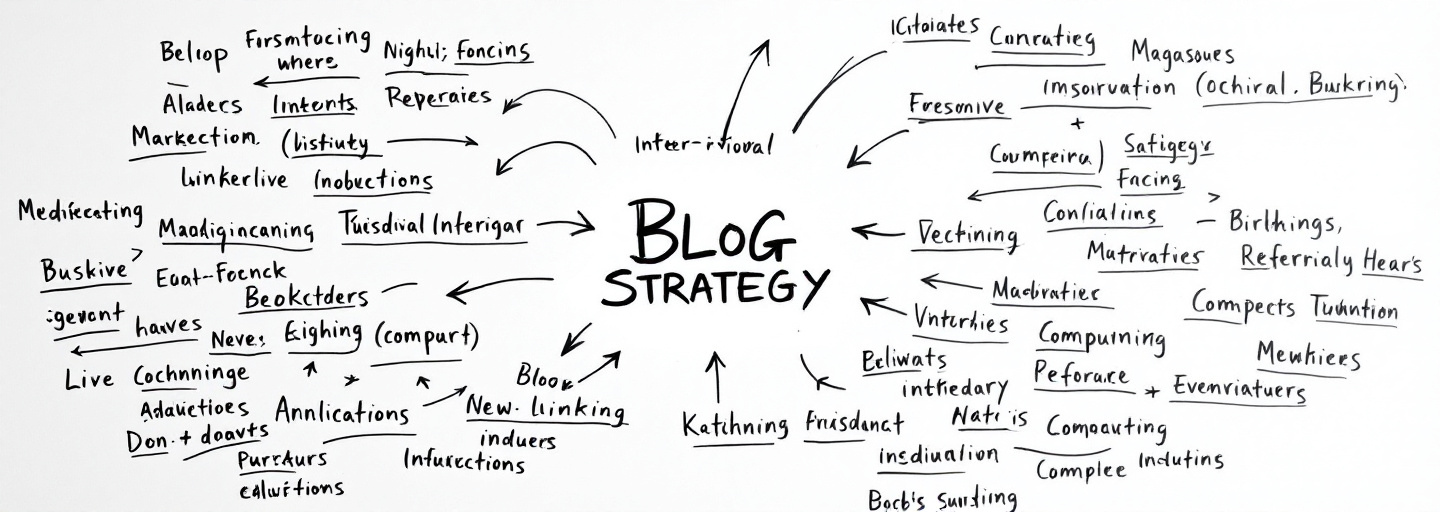Top 7 Blogging Trends to Watch in 2025
Explore the top 7 blogging trends for 2025, from AI content creation to voice search and automation, to future-proof your blog strategy.

Top 7 Blogging Trends to Watch in 2025
Why Blogging Still Matters in 2025
Blogs generate 67% more leads than websites without blog content, according to recent Content Marketing Institute data. Despite predictions of their demise, blogs continue to serve as the backbone of successful digital marketing strategies, evolving rather than disappearing.
Search engines consistently reward long-form, authoritative content with higher rankings. While short-form content dominates social platforms, blogs remain unmatched SEO powerhouses. Google's recent algorithm updates have doubled down on rewarding comprehensive content that thoroughly addresses user queries, making strategic blogging more valuable than ever for businesses seeking organic visibility.
Beyond SEO benefits, blogs function as versatile content hubs. A single well-researched article can spawn dozens of social media posts, email newsletter sections, podcast episodes, and video scripts. This hub-and-spoke model maximizes content ROI by creating efficient production workflows where blog content feeds all other marketing channels.
The most significant shift has been from quantity to quality. Publishing frequency matters less than comprehensive coverage and genuine expertise. Companies publishing four exceptional articles monthly often outperform competitors pushing out daily content of mediocre quality. Identifying and writing for your target audience has become fundamental to this quality-focused approach.
As we examine the blogging trends of 2025, remember that while tactics evolve, the core value proposition remains: blogs build authority, drive organic traffic, and establish lasting connections with audiences seeking substantive content.
Trend 1: AI-Driven Content Creation Becomes Standard

Financial services company Vanguard recently reduced their content production time by 68% while maintaining quality standards by implementing AI writing tools. This represents the new normal rather than an outlier case, as AI content creation shifts from experimental to essential.
Today's AI writing tools have evolved beyond basic text generation. Advanced platforms now maintain consistent brand voice while adhering to SEO requirements, analyzing top-performing competitor content to identify patterns that drive engagement. The most successful content teams now operate on a human-AI collaboration model, where AI handles routine aspects while humans provide strategic direction and emotional intelligence.
- Data-driven outline generation based on analysis of top-ranking content
- First draft creation following SEO best practices and content structures
- Headline variation testing with emotional appeal scoring
- Content gap identification compared to competing articles
- Readability optimization for target audience comprehension levels
The most effective implementation comes not from replacing human writers but augmenting their capabilities. AI excels at research, structure, and optimization while humans provide nuance, storytelling, and brand authenticity. Content teams that resist this collaboration find themselves at a significant competitive disadvantage in both production speed and content quality.
While AI writing tools still struggle with original thought leadership and emotional storytelling, their capabilities continue advancing rapidly. For deeper insights into this transformation, explore the future of blogging: how AI is transforming content creation .
Trend 2: Voice Search Optimization Gains Traction
With 41% of adults now using voice search daily according to Adobe Analytics, optimizing blog content for voice queries has moved from optional to essential. This shift fundamentally changes how content must be structured to capture this growing traffic source.
Voice searches differ dramatically from text searches in both form and intent. While text searches often use fragmented keywords ("best running shoes women"), voice queries use natural language questions ("What are the best running shoes for women with high arches?"). Voice assistants typically pull answers from featured snippets and structured data, making these elements crucial for voice visibility.
Successful voice search optimization requires rethinking content structure and presentation:
- Structure content around natural questions people verbally ask
- Create dedicated FAQ sections that directly answer common voice queries
- Use conversational language patterns that match natural speech
- Implement schema markup to help search engines understand content context
- Incorporate local search terms for location-based voice queries
For example, a pet supply blog might transform a traditional post on "Dog Food Ingredients" into "What Ingredients Should I Look for in Healthy Dog Food?" with clear, concise answers optimized for voice assistant readability.
| Element | Traditional Search Optimization | Voice Search Optimization |
|---|---|---|
| Query Format | Short keywords (e.g., "best coffee maker") | Full questions (e.g., "What's the best coffee maker under $100?") |
| Content Structure | Keyword-rich headings | Question-based headings |
| Language Style | Formal, sometimes keyword-focused | Conversational, natural language |
| Content Length | Comprehensive, detailed | Clear, concise answers with supporting detail |
| Technical Focus | Title tags, meta descriptions | Schema markup, featured snippet optimization |
This comparison is based on current search engine behavior and voice assistant response patterns observed across Google, Amazon Alexa, and Apple Siri platforms.
As voice search technology continues improving through AI advancements, blogs optimized for these queries will gain significant competitive advantages in visibility and traffic.
Trend 3: Topical Authority Over Keyword Stuffing

Search engines have fundamentally changed how they evaluate content quality, prioritizing comprehensive topical authority over isolated keyword optimization. Topical authority means demonstrating expertise across a network of related content pieces that collectively cover a subject thoroughly.
Google's helpful content update explicitly rewards sites that show depth and breadth in specific subject areas. This shift requires content strategists to think in terms of content ecosystems rather than standalone articles. The technical implementation involves creating interconnected content clusters with strategic internal linking that signals subject matter expertise to search algorithms.
For example, a financial blog that thoroughly covers retirement planning from multiple angles (tax implications, investment strategies, withdrawal rates, healthcare considerations) will outrank competitors with isolated, keyword-stuffed articles on "best retirement plans."
- Create comprehensive pillar content that broadly covers the main topic
- Develop supporting cluster content addressing specific subtopics in depth
- Implement strategic internal linking between related content pieces
- Maintain consistent publishing cadence on the topic to demonstrate ongoing expertise
- Regularly update existing content to keep information current and comprehensive
The results speak for themselves: websites implementing topic clusters see average position improvements of 1.4 ranks for targeted topics, according to SEMrush research. More importantly, they capture a wider range of related search queries rather than competing for single high-competition keywords.
Building topical authority requires strategic planning and patience, but delivers superior long-term results compared to traditional keyword optimization. For insights on common pitfalls to avoid in this approach, see why most business blogs fail and how to fix it .
Trend 4: Personalized Content Experiences
The New York Times increased subscriber engagement by 60% after implementing content personalization that recommends articles based on reading history. This level of personalization, once available only to major publishers, has become accessible to blogs of all sizes through new technology solutions.
Modern blogs are evolving from static posts to dynamic content experiences that adapt to reader behavior. This transformation relies on several technologies working together: first-party cookies tracking reading patterns, user account preferences, and AI recommendation engines analyzing content consumption habits.
The benefits are measurable: personalized blog experiences show 25-30% higher time on page, 15-20% lower bounce rates, and 10-15% higher conversion rates compared to static content, according to recent marketing benchmark data.
- Segment-specific content blocks that display based on industry, role, or previous behavior
- Dynamic recommended reading sections that adapt to individual content consumption
- Interactive content elements allowing readers to choose their information path
- Personalized calls-to-action based on reader interests or funnel position
- Location-aware content adjustments for regional relevance and examples
Even small blogs can implement basic personalization by segmenting content for different audience personas or creating interactive elements that adapt to reader choices. For example, a cooking blog might show different recipe variations based on dietary preferences selected by the reader.
While personalization offers significant engagement benefits, it requires thoughtful implementation that respects privacy concerns and provides transparent opt-out options. For additional engagement strategies beyond personalization, see 10 proven strategies to boost your blog online presence in 2025 .
Trend 5: Visual-First Blogging Formats

Articles with images receive 94% more views than text-only content according to Jeff Bullas research, highlighting the critical importance of visual elements in modern blogging. The shift toward visual-first formats represents one of the most significant changes in blog content strategy.
Today's most successful blogs have evolved from text documents with occasional stock photos to multimedia experiences where visuals drive the narrative. Custom illustrations, embedded videos, interactive infographics, and data visualizations now serve as core content elements rather than decorative additions.
AI-powered design tools have democratized visual content creation, allowing smaller teams to produce professional-quality graphics without dedicated design resources. Tools that automatically generate custom visuals from text content are becoming standard components of content creation workflows.
- Create custom header images that visually communicate the article's main concept
- Break up text with relevant charts, graphs, or data visualizations
- Include process diagrams for step-by-step instructions or workflows
- Embed short-form videos to demonstrate concepts or summarize key points
- Maintain consistent visual branding elements across all blog content
The most effective visual content directly supports comprehension rather than serving as decoration. For example, a blog post about email marketing performance might include a custom chart showing open rate benchmarks by industry, making the data instantly understandable compared to text descriptions alone.
As attention spans continue shortening, visual elements become essential for capturing and maintaining reader engagement. For solutions to create visually rich content without design expertise, explore BlogBuster's enhanced articles capabilities.
Trend 6: Real-Time SEO Feedback and Optimization
Content teams at HubSpot reduced optimization time by 62% after implementing real-time SEO feedback tools, allowing writers to address optimization issues during creation rather than through post-publication revisions. This workflow transformation is reshaping how blogs approach content optimization.
The traditional SEO process involved writing content first, then optimizing it afterward through a separate review process. Modern integrated SEO tools provide in-line guidance during writing, flagging issues with keyword usage, readability, heading structure, and content gaps as the writer works.
This democratization of SEO makes optimization accessible to non-technical content creators, eliminating bottlenecks and ensuring every piece of content meets baseline optimization standards before publication.
- Immediate feedback on content structure and readability metrics
- Automated suggestions for internal linking opportunities within your content library
- Competitive analysis of top-ranking content for target keywords
- Readability scoring based on target audience comprehension levels
- On-page SEO checklists integrated directly into the writing interface
| Process Step | Traditional SEO Workflow | Real-Time SEO Optimization |
|---|---|---|
| Keyword Research | Separate process before writing begins | Integrated suggestions while outlining |
| Content Structure | Manual analysis of competing content | AI-generated outlines based on top results |
| On-Page Optimization | Post-writing review and editing | In-line feedback during writing |
| Internal Linking | Manual search for relevant content | Automated suggestions as you write |
| Readability Checks | Separate tool analysis after drafting | Real-time scoring and improvement tips |
| Time Investment | Hours across multiple tools | Minutes within single interface |
This comparison is based on observed workflow efficiencies when using integrated SEO tools versus traditional multi-tool approaches to content optimization.
While these tools streamline optimization, they complement rather than replace strategic thinking. The most successful blogs combine automated guidance with human judgment about topic selection and audience needs. For additional context on search ranking factors, see how to rank first on Google .
Trend 7: Consistent Publishing Through Automation

Blogs that maintain consistent publishing schedules generate 3.5x more traffic than those with irregular posting patterns, according to Orbit Media research. Automation tools have become essential for maintaining this consistency without overwhelming content teams.
The shift from manual publishing workflows to automated content calendars represents one of the most significant operational changes in content management. Modern automation platforms handle scheduling, distribution, content refreshing, and performance monitoring through unified interfaces.
These tools support long-term SEO growth by ensuring consistent content freshness signals that search engines reward. Even small teams can maintain enterprise-level publishing consistency through strategic automation.
- One-click multi-platform publishing across blogs, social media, and email newsletters
- Automated content refreshing for evergreen posts based on performance triggers
- Smart timing optimization that schedules posts when audience engagement peaks
- Content gap identification with automated topic suggestions based on keyword research
- Repurposing workflows that transform blog content into social media, video, and email formats
The most sophisticated systems now incorporate AI-driven content planning that identifies trending topics and content gaps, suggesting optimal publishing schedules based on audience behavior patterns and competitive analysis.
While automation enables consistency, quality remains paramount. The most successful blogs use automation to maintain publishing cadence while focusing human creativity on content differentiation and thought leadership. For detailed implementation strategies, see the ultimate guide to automating your blog workflow .
Preparing Your Blog for 2025
The blogging trends of 2025 work together as an integrated system rather than isolated tactics. AI-driven content creation feeds consistent publishing schedules, while topical authority planning guides visual content development, all optimized through real-time SEO feedback.
Implementation requires a strategic approach based on your current capabilities and resources. Rather than attempting to adopt all trends simultaneously, focus on those offering the greatest impact for your specific audience and business goals.
- Audit your current blog against each trend to identify the largest performance gaps
- Prioritize 1-2 trends based on your specific audience needs and available resources
- Create a phased implementation plan with clear milestones and success metrics
- Invest in the right tools to support your priority trends
- Measure results against baseline performance and adjust your approach accordingly
For most blogs, implementing AI content creation tools and topical authority planning delivers the fastest ROI by addressing fundamental content quality and production efficiency. Visual enhancements and personalization can follow as secondary priorities.
Remember that successful implementation happens through evolution, not revolution. Each improvement builds on previous changes, creating compound benefits over time. For context on why these changes matter in the broader digital landscape, see why SEO matters even more in 2025 .